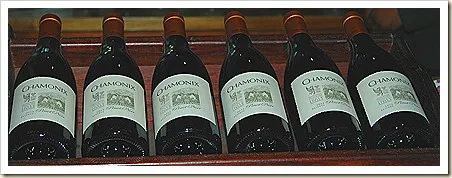Monday, July 6, 2015
Chamonix: South Africa Winery Visit
Continuing the saga of our wine and safari expedition to South Africa…
The last winery visit during our stay in Franschhoek, the wine and food capital of South Africa, was Chamonix Wine Farm. My wife was getting tired from our long day of tasting, but I was determined to visit this one-of-a-kind winery.
Chamonix has a restaurant with a deck that protrudes into the forest, a tasting room in a blacksmith’s cottage that leads to and underground cellar and a mountain backdrop with an elevated view of the valley. It also has some splendid wine.
After working our way past a boisterous crowd on the deck, we settled in for a tasting inside the blacksmith cottage. Green Dragon, who was getting a bit grumpy, soon brightened as she picked a prime spot near the fireplace.
We began our premium tasting (which cost the “outrageous” sum of $3.32 each US) with the 2014 Unoaked Chardonnay. The Chard is fermented in stainless steel tanks and then spends four to six months on lees to give it more body. There are snippets of apple and grapefruit flavors and a lively acidity.
The 2013 Reserve White is a blend of 55% Sauvignon Blanc and 45% Semillon. It undergoes barrel fermentation and then is aged for 11 months in French barriques. Barriques are small barrels and their use can result in more prominent oak characteristics. This straw colored wine has a full body and an exotic nose.
Move to the reds, we began with a pair of Pinot Noirs. The high quality of Pinot in South Africa was a surprise to me. First up was the 2013 Feldspar Pinot Noir. It is medium bodied with sour cherry flavor. The 2013 Pinot Noir Reserve is a superior wine from the best block of Pinot Noir grapes. It is naturally fermented and barrel ages for 16 months. This is a complex Pinot with notes of caramel and toffee blending with cherries and violet. This was a steal at 270R (about $22 US).
Rounding out the tasting was the 2012 Rouge and the 2013 Greywacke Pinotage. The Rouge is a blend of Cabernet Sauvignon, Merlot, Petit Verdot and Malbec. It’s a satisfactory blend, but dimmed in comparison with the Pinot Noir and the Pinotage. Greywacke is a type of soil, in case you’re wondering.
The Pinotage uses the ripasso technique whereby a portion of the grapes used are partly dried and then added whole to the wine for a second fermentation. The wine undergoes malolactic fermentation and then is aged in oak for two years. That’s a lot of lovin’ in the wine making process and the results show. The Pinotage is a complex blend of flavors with berries and spice tinged with chocolate.
Chamonix exhibits the same skill in winemaking that the village blacksmith did centuries ago – forging outstanding wine in a unique setting. This is a recommended visit during the Cape Winelands tour.
Subscribe to:
Post Comments (Atom)






No comments:
Post a Comment